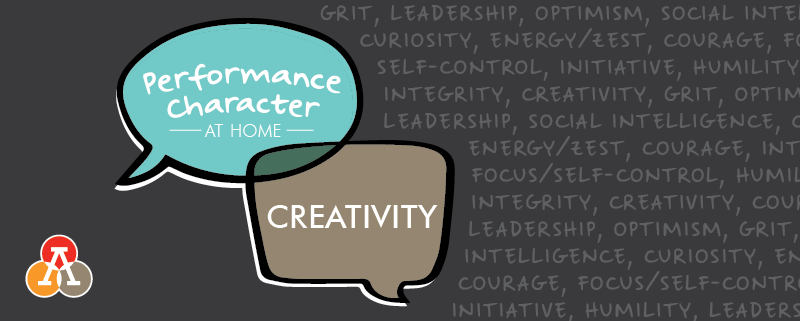“Creativity is seeing what everyone else has seen, and thinking what no one else has thought.”
– Albert Einstein
At Athlos Academy, we teach children the importance of 12 traits that we call Performance Character traits. Our Performance Character pillar recognizes the deep connection between these character traits and success. The development of Performance Character is integrated into every learning opportunity, allowing students to experience this connection first hand. Traits like leadership, integrity, courage, and optimism become a lens through which students view their learning as about more than grades, but as learning for life.
Like all important lessons, reinforcing learning at home is a key factor to success. One of the best ways for parents to do this is to positively model the traits at home and to encourage trait development. In our 12-part ‘Performance Character at Home’ blog series, we offer some simple, yet effective ways to support children’s Performance Character development. In this blog, we look at creativity.
 What is creativity?
What is creativity?
Athlos defines creativity as thinking “outside the box” and solving problems with innovation.
Why is creativity important?
Creativity is not something you either have or don’t have. It’s a skill like any other and important for living a healthy and happy life. Creativity is also not limited to artsy endeavors like music or painting. In fact, creativity is required for success in math, science, and language arts and improves a child’s ability to learn in many ways. For children, developing divergent thinking strategies is essential to success in the classroom and in life. Thinking creatively enables children to approach problems with a wide range of ideas, to react with flexibility to changing routines, and to find new ways to approach old problems.
How can I help my child develop creativity?
There are so many great ways to reinforce creativity at home. Here are just a few to try:
- Encourage your child to think of new ways to use common household items. For example, ask your child how many ways they can use a placemat. Encourage them to come up with uncommon ways to think of the placemat; they may roll it up and turn it into a telescope, throw it like a Frisbee, or color on a paper on top of the mat to create a textured drawing.
- This one is simple in execution but could test your ability as a parent to let go of control. Avoid giving direction when asking your child to accomplish certain tasks. Instead, watch their process and see how they choose to accomplish the task. If they become frustrated and want guidance, help them understand that there are many ways to accomplish one task or solve one problem, and that no one way is the right way.
- Like movement breaks and free play present in Athlos classrooms, provide opportunities for your child to play creatively without a lot of adult interference or guidance.
- Encourage your child to tell you stories. Let them make up fun scenarios with characters they have developed. When reading a book, ask them to come up with alternate endings to the story and imagine ways the story would change if the characters in the book made different decisions or actions.
- Have a trait conversation with your child about the role that creativity plays in their school day, asking questions like:
- How did you show creativity today?
- How was creativity important during your classroom instruction or on the turf?
- How could you show creativity at school, at home, etc.?























